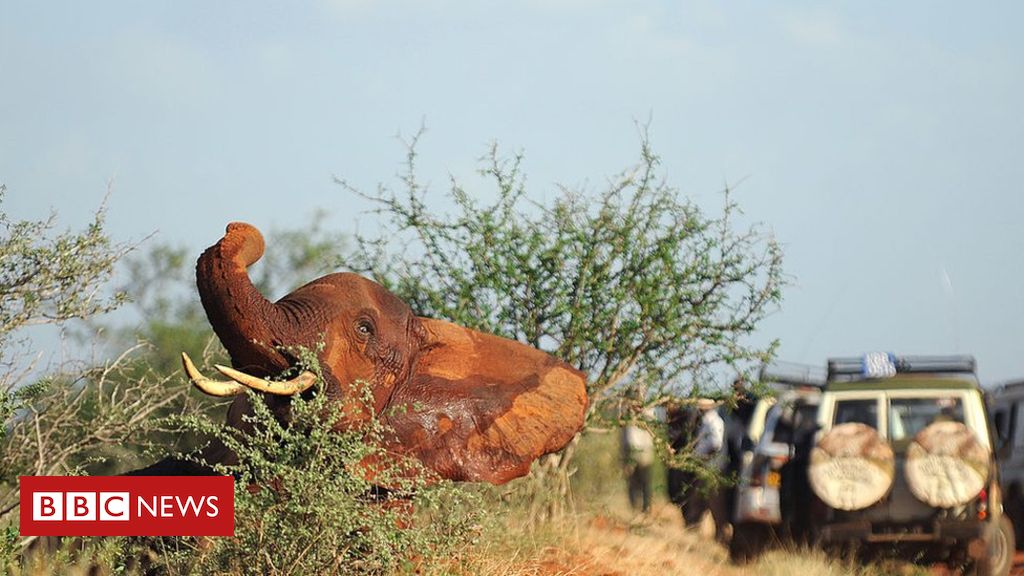
Image copyright
Getty Images
Different approaches to protecting elephants are set to dominate the debate at a key conservation conference starting in Geneva today.
Delegates from more than 180 countries are gathering for the meeting of the Convention on International Trade in Endangered Species (Cites).
Some African nations are again pushing to reopen the trade in ivory.
However others are seeking the highest possible protections for all of Africa’s elephants.
The Cites meeting, held every three years, will discuss a record 56 proposals submitted by governments to the Conference of the Parties, known as COP18.
The COP was due to be held in Sri Lanka earlier this year but was moved to Switzerland in the wake of the bomb attacks at Easter.
Key among the items on the agenda will be competing ideas on how to protect African elephants, which have seen a huge decline in numbers due to poaching over the past 20 years.
A study published in 2016 estimated that 30-40,000 of the giant creatures were killed by poachers every year with roughly 400,000 left in total.
In many parts of Africa, elephants are protected under Cites Appendix I, which means that trade is only permitted under exceptional circumstances.
Image copyright
Getty Images
At this meeting, Zambia is seeking to have its elephants downlisted to Appendix II. This would allow a commercial trade in registered raw ivory with approved trading partners.
Botswana, Namibia and Zimbabwe are also proposing that ivory from elephants in their region be traded.
On the other end of the scale, a number of countries including Kenya, Nigeria and Gabon are proposing that all elephants in Africa be listed as Appendix I, the highest form of protection available to Cites.
“The elephant is in the centre of the debate once again,” said Vera Weber from the Franz Weber Foundation, which campaigns to protect endangered species.
“Only five countries want to re-open the trade in ivory but there is a 32-country bloc with the African elephant coalition that want full protection and a complete ban on ivory trade.”
While all the elephant proposals are considered unlikely to reach the two thirds majority needed to change the rules, some environmentalists are concerned that the European Union will support the Zambian proposal if the Zambians establish a zero quota and agree to not sell any ivory into approved markets.
Vera Weber believes this would be a disastrous signal to send.
“Thirty years ago in 1989, the parties decided to vote for the uplifting of African elephants and this basically saved the elephant from extinction,” she told BBC News.
“And now we look at the recently released IPBES report that says that a million species are going towards extinction in the next years, so now is not the moment to speak about any trade in endangered species and the African elephant is an endangered species.”
‘Silent extinction’
As well as elephants there are likely to be significant debates at this meeting over giraffes, sharks, rhinos and a number of threatened plant and tree species.
Some environmentalists are very concerned about giraffes, who they say are suffering a “silent extinction” with numbers dropping by 40% over the last 30 years because of habitat loss, civil unrest, illegal hunting and the international trade in body parts.
Image copyright
Getty Images
For the first time a proposal to protect giraffes is on the agenda
For the first time at Cites, there is a proposal to give these giraffes a measure of protection from trade.
“It is important that giraffes are listed by Cites because currently we can’t say for certain how much of their huge population decline is due to trade,” said Matt Collis from the International Fund for Animal Welfare.
“We do know it is a significant factor though as the only country that currently collects data on trade in giraffes, the US, has reported almost 40,000 giraffe items traded in a decade, from 2006 to 2015.”
Sharks are also the subject of efforts to increase protection. Six years ago at the Cites meeting in Thailand, a number of shark species were listed for the first time. Now at this meeting there are proposals to list a further 18 of the most threatened species including both the longfin and shortfin mako shark.
Image copyright
Getty Images
A Saiga antelope released in Southern Russia
Another species where countries are seeking to tighten trade restrictions is the Saiga antelope, mainly found in Russia, Mongolia and Kazakhstan. A bacterial infection wiped out huge numbers of the animals in 2015 but it also suffers from poaching due to demand from traditional medicine.
The US and Mongolia are seeking a ban on all international trade in the species, a move that is being vigorously opposed by Kazakhstan, who say that numbers are starting to rise.
One other proposal gaining attention, even if it is not likely to secure a majority, is from Israel.
They are asking the conference to restrict trade in an extinct animal, the woolly mammoth. The intention is to try to stop poachers passing off elephant ivory as mammoth tusks which are sometimes collected in Siberia from melting permafrost.
Follow Matt on Twitter @mattmcgrathBBC

















API has been taken down : pushshift